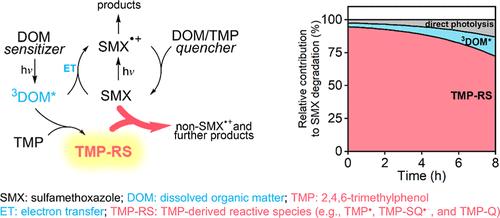从猝灭剂到促进剂:重新审视2,4,6-三甲基苯酚(TMP)在溶解有机物三态光化学中的作用
IF 11.3
1区 环境科学与生态学
Q1 ENGINEERING, ENVIRONMENTAL
引用次数: 0
摘要
三态溶解有机物(3DOM*)在环境水生光化学中起着至关重要的作用,2,4,6-三甲基苯酚(TMP)因其与3DOM*的高反应活性而经常被用作化学探针或猝灭剂。然而,tmp衍生的氧化中间体对目标光化学反应的影响尚未得到全面的研究。本研究考察了在不同DOM源或模型光敏剂存在下,TMP对天然水体中常见抗生素磺胺甲恶唑(SMX)光解的影响。与预期相反,TMP显著加速SMX光解,其增强程度取决于TMP和DOM浓度。激光光解和动力学模拟表明,长寿命的tmp衍生反应物质(TMP-RS),包括苯氧基自由基、半醌自由基和醌类自由基,是这一过程的关键因素。与3DOM*不同,TMP-RS可与SMX反应生成非SMX•+中间体。这个过程防止SMX•+的减少和随后的SMX再生。该动力学模型成功地预测了反应过程中各种因素对SMX氧化的动态贡献,突出了TMP-RS的关键作用。这项研究促进了我们对TMP参与三态光化学的理解,并建议重新考虑长寿命有机RSs在环境微污染物转化中的作用。本文章由计算机程序翻译,如有差异,请以英文原文为准。

From Quencher to Promoter: Revisiting the Role of 2,4,6-Trimethylphenol (TMP) in Triplet-State Photochemistry of Dissolved Organic Matter
Triplet-state dissolved organic matter (3DOM*) plays a crucial role in environmental aquatic photochemistry, with 2,4,6-trimethylphenol (TMP) frequently used as a chemical probe or quencher due to its high reactivity with 3DOM*. However, the influence of TMP-derived oxidation intermediates on the target photochemical reactions has not been comprehensively examined. This study investigated TMP’s effect on the photolysis of sulfamethoxazole (SMX), a common antibiotic found in natural waters, in the presence of different DOM sources or model photosensitizer. Contrary to expectation, TMP significantly accelerated SMX photolysis, with the extent of enhancement depending on TMP and DOM concentrations. Laser flash photolysis and kinetic modeling suggested the long-lived TMP-derived reactive species (TMP-RS), including phenoxyl radicals, semiquinone radicals, and quinones, as the key factors in this process. Unlike 3DOM*, TMP-RS may react with SMX with the formation of non-SMX•+ intermediates. This process prevents the reduction of SMX•+ and the subsequent regeneration of SMX. The kinetic model successfully predicts the dynamic contributions of various factors to SMX oxidation during the reaction, highlighting the critical role of TMP-RS. This study advances our understanding of TMP’s involvement in triplet-state photochemistry and suggests a reconsideration of the role long-lived organic RSs play in the transformation of environmental micropollutants.
求助全文
通过发布文献求助,成功后即可免费获取论文全文。
去求助
来源期刊

环境科学与技术
环境科学-工程:环境
CiteScore
17.50
自引率
9.60%
发文量
12359
审稿时长
2.8 months
期刊介绍:
Environmental Science & Technology (ES&T) is a co-sponsored academic and technical magazine by the Hubei Provincial Environmental Protection Bureau and the Hubei Provincial Academy of Environmental Sciences.
Environmental Science & Technology (ES&T) holds the status of Chinese core journals, scientific papers source journals of China, Chinese Science Citation Database source journals, and Chinese Academic Journal Comprehensive Evaluation Database source journals. This publication focuses on the academic field of environmental protection, featuring articles related to environmental protection and technical advancements.
 求助内容:
求助内容: 应助结果提醒方式:
应助结果提醒方式:


